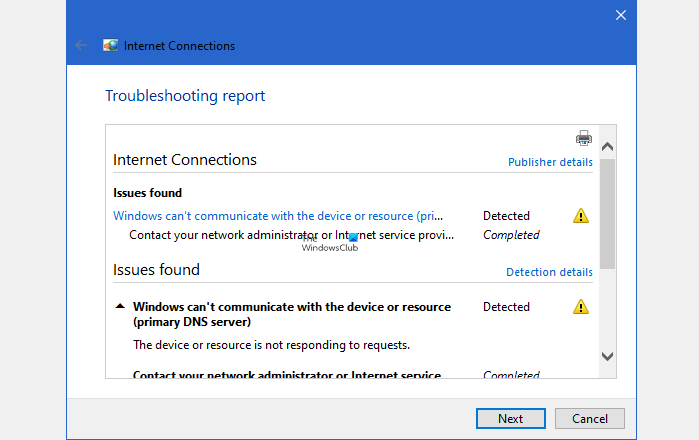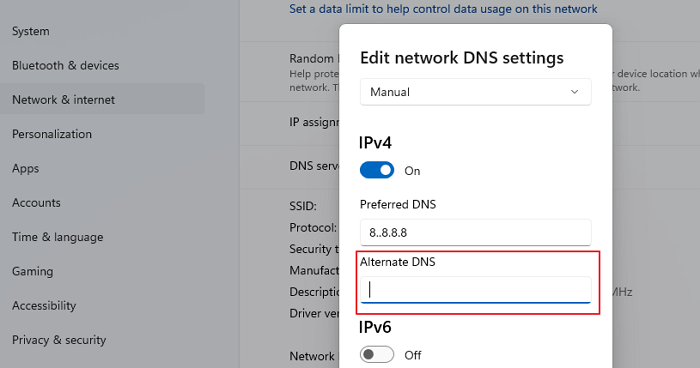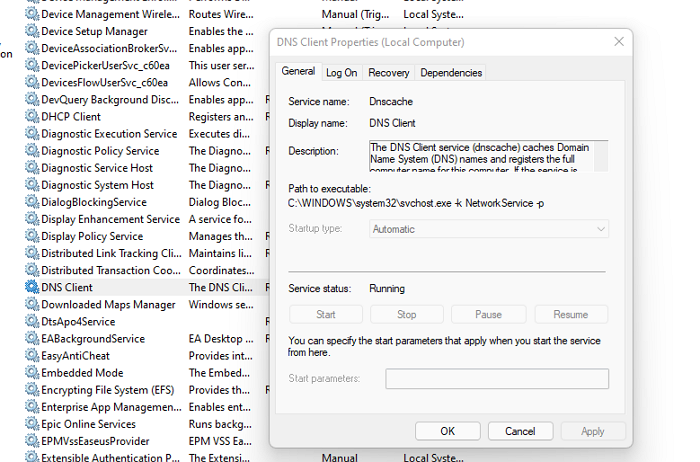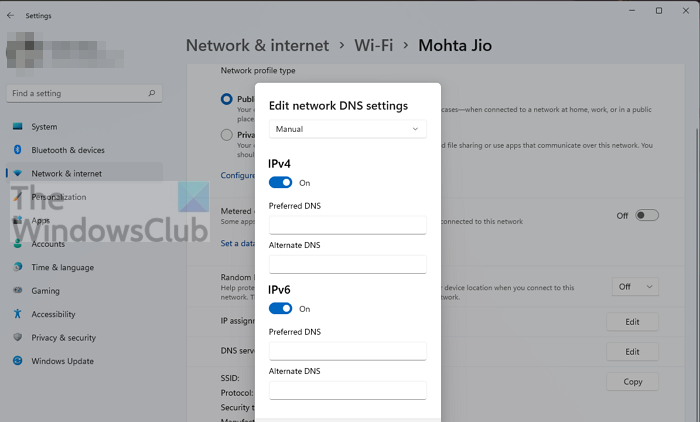DNS issues are not new, and they could be one of the major causes of the internet not working. When using the built-in Internet Connections Troubleshooter in Windows 11/10, if you receive an error saying that Windows can’t communicate with the device or resource (Primary DNS Server), this post will look at ways to resolve this.

What is a Primary DNS Server?
When configuring DNS Server in Windows or the Router, two entries are taken. First is the primary, and then the secondary. This is a failsafe where a website can still be opened if the first DNS server fails to respond.
Windows can’t communicate with the device or resource (Primary DNS Server)
Your ISP configures a DNS server, or you can manually set it on your router or PC if you are using the public DNS such as Cloudflare, Google, and others. Since the error message clearly says it cannot communicate, we need to resolve the connection issue.
- Restart Router or PC
- Add a Secondary DNS
- Check on DNS and DHCP Client
- Change DNS
Follow these methods to fix the Windows problem that can’t communicate with the device or resource (Primary DNS server).
1] Restart Router or PC
Sometimes the hardware gets stuck and needs a restart. I would recommend restarting both the router and the PC as the first step to troubleshooting. It will reset whatever it’s holding temporarily, and reload the configured settings, and start fresh.
2] Add a Secondary DNS

Are you missing a secondary DNS? While it’s rare, if you have manually configured the DNS and did not enter the secondary DNS, and the primary DNS is failing, then this can be the root cause of the problem. It is also called an Alternate DNS in some of the settings.
3] Change DNS
It is always preferable to use Public DNS. The list includes Google DNS, Cloudflare, Quad9, OpenDNS, Comodo Secure DNS, and more. Some of these DNS are paid, while others are free. Unless you need a paid service, free services should be good enough to get you started.
4] Ensure Your DNS Client and DHCP Client Are Running

These two services need to be running to ensure there is no DNS-related error because of it.
- DHCP Client Service registers and updates IP addresses and DNS records for the PC. If this service is stopped, this computer will not receive dynamic IP addresses and DNS updates.
- DNS Client Service or dnscache names and registers the full computer name for this computer. If the service is stopped, there will be no caching.
Type services.msc in the Run Prompt and press the Enter key. It will open the Services window. Locate DNS Client and DHCP Client, and ensure they are running.
How Do I Resolve DNS Issues?
If restart the PC and router don’t help, and you have already cleared the cache, then it would be best to use a VPN or another DNS resolver. It will help you figure out if the ISP is the problem that happens many a time.
How Do I Check My DNS Settings?

On the router, you need to check on the configuration where the ISPs IP settings are configured. If everything is configured on your PC, then go to Settings > Network & Internet. Click on Properties, and then click on the Edit button next to the DNS server assignment. Here you can view the settings.
What Is a Good DNS To Use?
There is no particular definition of Good DNS, but using Cloudflare, Google DNS, and others on similar lines can deliver better performance than the ISP.
What Is a Secondary DNS?
If the primary server that resolves website name to IP address aka DNS fails, the PC sends the same query to secondary DNS. It ensures if the query is taking too long or is not available, the user can still access the website. Once resolved, the computer stores it locally and doesn’t query the DNS again until the cache expires.
How to Clear Your DNS Cache?
Once a website IP address is resolved, it is kept in the cache. The next time the browser requests it again, the local cache is used to resolve it quickly instead of querying it with the DNS. If the website is not using that IP address anymore, then the website may fail to resolve. Check our detailed guide on how you can clear the DNS cache.
Does DNS change your IP address?
No, it cannot. An IP address is allocated either manually or using DHCP. It’s a different function that is not part of the DNS Server. The function of DNS is to resolve website to IP address and fast.
This error is external, and there is little you can do. While you can restart the services on the client PC, checking using an alternate external DNS server is important to ensure it’s not a PC problem. When changing the DNS server, make sure to note down the old.
I hope the post resolved your error, and you can browse as usual.